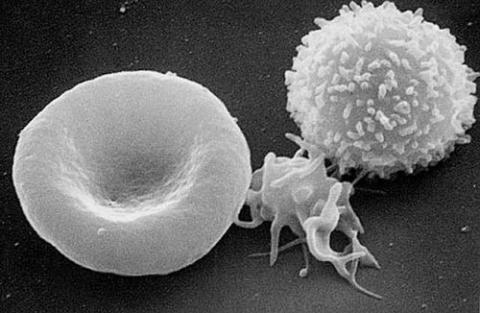Robot Camera
Problem
- An average human hair has a diameter of about 50 microns. How many nanometres is this?
- Measure the height of a new pack of printer paper. Packs come in reams which contain 500 sheets of paper: estimate the thickness of one piece of paper. What is this in nanometres? What is it in microns?
Do you think that it will be possible in principle to make a robot camera using nanotechnology which could be injected into a person's arteries in order to see if they are becoming blocked? You will need to consider what size a robot would need to be to move along an artery in the blood stream.
Here is some information to get you started:
- the interior diameter of the coronary arteries is about 1-2 mm
- blood contains red and white blood cells and platelets
- red blood cells (erythrocytes) are about 6-8 microns in diameter
- white blood cells (leukocytes) are about 15 microns in diameter
- platelets (thrombocytes) are about 2-3 microns in diameter
Here is an image of blood components taken from http://en.wikipedia.org/wiki/File:Red_White_Blood_cells.jpg

Student Solutions
The answers to the two preliminary questions are:
1. The average human hair has diameter 50 microns, which converted to nanometers is 50,000 nanometers (recall that $1 \mu \textrm{m} = 10^3 n \textrm{m} $).
2. A ream of paper containing 500 sheets is approximately 10 cm tall. So, since it contains 500 sheets, we deduce that each sheet has thickness 0.02 cm, which converted is 0.2 mm, 200 $\mu$m or 200,000 nm.
Now, in order to create a robot camera, one would need to inject it into a human's blood arteries, and it would need to circulate with ease around them. The coronary arteries are among the narrowest arteries in the human body, so there is no need to go into even smaller dimensions.
However, we do need to bear in mind that the camera is being built for the purpose of identifying whether the arteries are becoming blocked, and therefore we might want to ensure that it will be able to circulate inside, even if this is the case. An artery is consider to be in a critical condition, if more than 75% of its interior is filled by a thrombus (i.e. a blood clot which blocks blood circulation). At this stage, the patient already has symptoms, so the detection is not really necessary. Still, in order for a camera to be able to circulate freely inside the artery, it shouldn't be wider than 20% of the artery's interior diameter, which means in our case 0.1 mm = 100 microns.
Since nanotechnology, and in particular nanorobotics, has reached the stage where robots with dimensions of order of nanometers are now being created, such a robot camera, would be possible in principle. Of course, though, this is simply a theoretical thought and chances are that nanorobotics will need to advance a lot in order to generate such devices.
Teachers' Resources
Why do this problem ?
Nanotechnology is an important area of research for new products. This problem uses a medical context for students to think about estimation and orders of magnitude. These are crucial mathematical skills in the sciences. This problem could be tackled by individual students or it could be tackled jointly by a whole class.Possible approach
The first two questions will help students in working with very small numbers, including finding out what the units mean. The class could then discuss whether they think it is possible in principle to make a camera suitable for injecting into an artery, before embarking on any calculations.Key questions
Do you have all the information you need? If not, where can you find out what you need?What formulae will you need to use?
How accurate do you think your answer is?
What 'order of magnitude' checks could you make to test that your answer is sensible?
